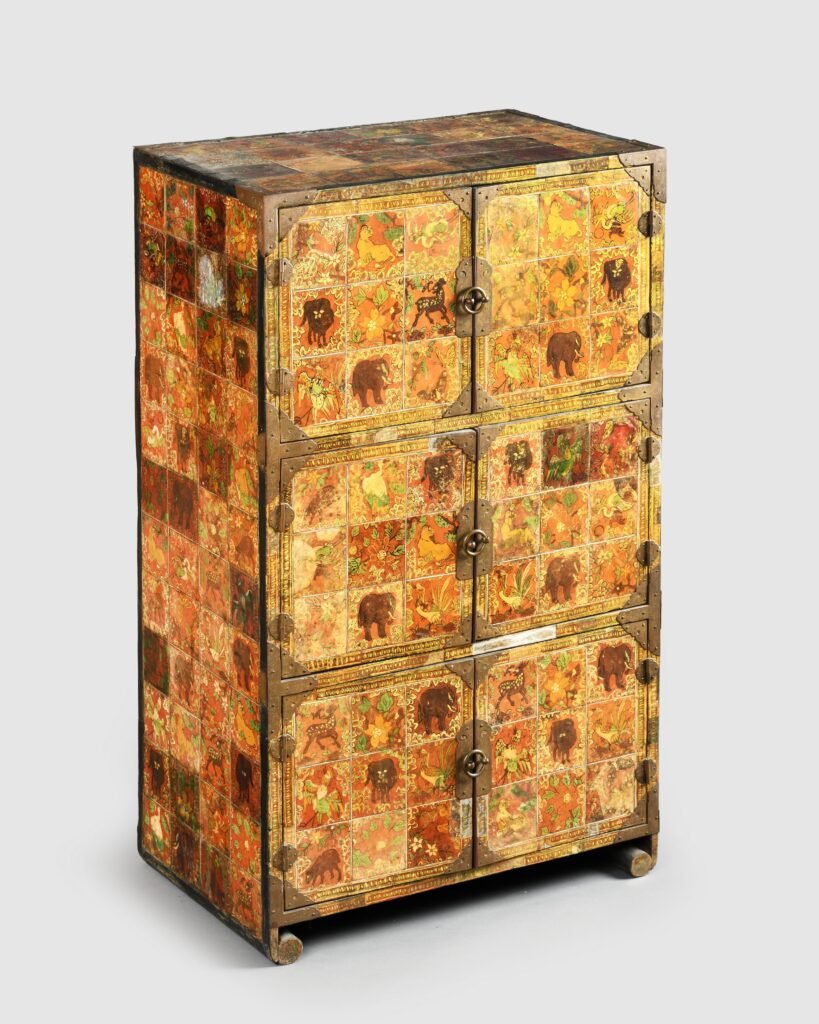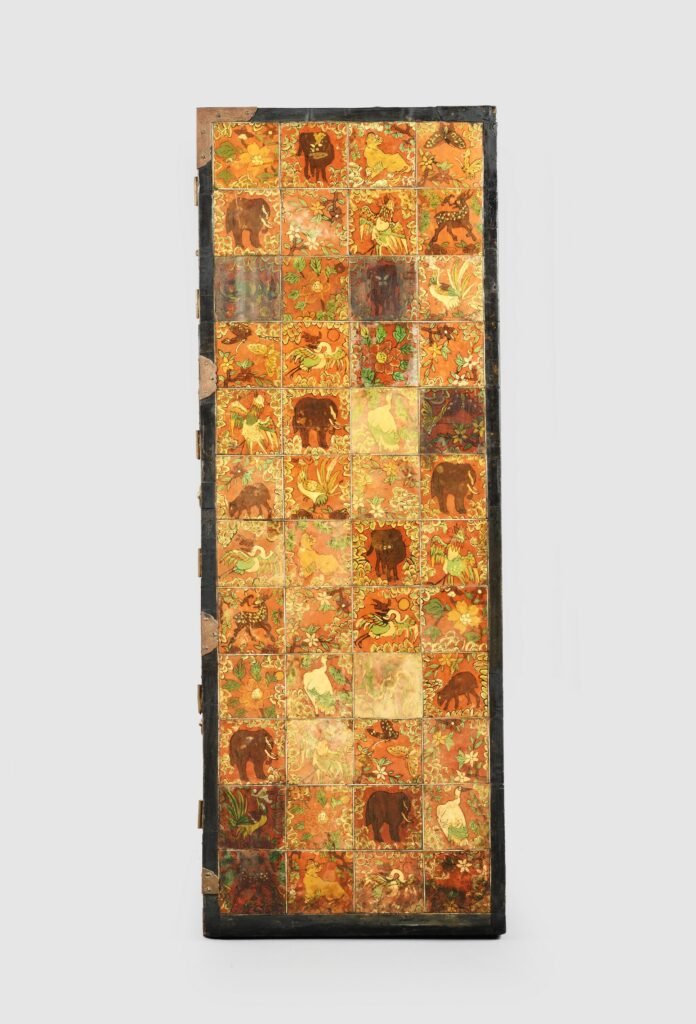Featured image on top of this post: Box with design of auspicious symbols, early 20th century.
Ink and paint on ox horn panels on wood, ray skin, and metal.
DETROIT INSTITUTE OF ART MUSEUM, USA
The term “hwagak” is derived from the words for flowers and horns, and it specifically pertains to the craft of inlaying ox horns. The highest quality horns for hwagak are obtained from three-year-old oxen that have been exclusively fed grains, as they exhibit superior transparency.
The process of creating hwagak commences with the heating and flattening of the ox horns, followed by grinding them into paper-thin veneers. Subsequently, skilled artisans adorn the reverse side of the veneers with traditional patterns using a variety of colors.
These painted veneers are affixed to wooden items using fish glue. Finally, the artisan meticulously grinds the surface of the veneers until they are incredibly thin, measuring just 0.045 millimeters in thickness, ensuring that the intricate painting on the reverse side becomes visible.
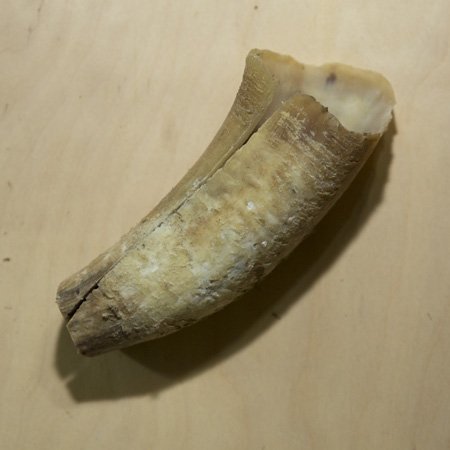
Hwagak making bears similarities to the ancient Chinese tortoise shell craft. During the Goryeo Kingdom, tortoise shell lacquer was applied to rosary cabinets and other pieces of furniture.
Due to the scarcity of tortoise shells in Korea, artisans turned to ox horns, which possess similar qualities, for crafting items intended for royal families and aristocrats.
The world of ox-horn craft boasts a multitude of motifs, making it challenging to enumerate them all. Nonetheless, these motifs are typically categorized into either animals or plants, and they are laden with wishes for good fortune.
They encompass a wide array of motifs, such as the 10 creatures of longevity, dragons, phoenixes, magpies, and tigers, as well as depictions of flowers and birds.
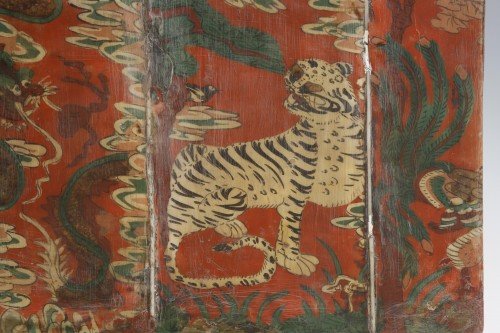
Late 19th century. Museum of Applied Art, Frankfurt, Germany.
The items decorated with hwagak range from large furniture such as wardrobe, cabinets and chests of drawers to small objects including jewelry boxes, vanity chests, baskets, combs, rulers and spools. Traditionally used to decorated mainly women’s personal belongings.
INTERESTING LINKS:
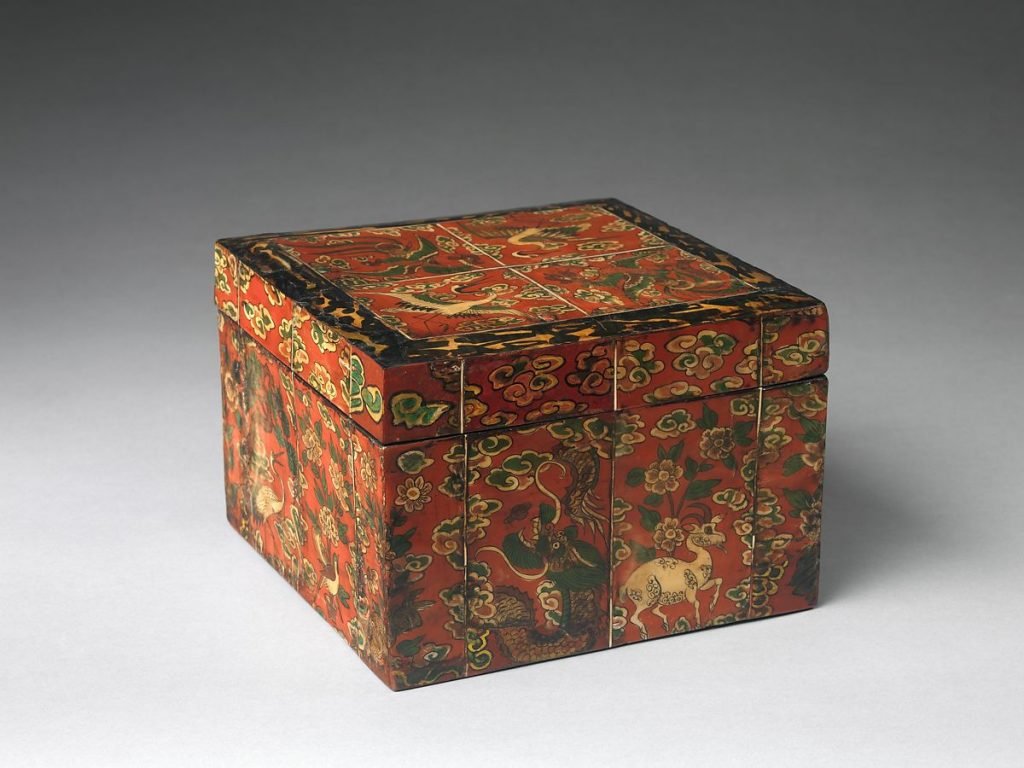
19th century, Korea.
Decorative motifs on this piece include animals symbolizing good fortune, longevity, or protection, such as cranes, deer, dragons, phoenixes, and tigers. Similar imagery was also popular on paintings and ceramics during the nineteenth century.
THE MET MUSEUM, NEW YORK. USA

Christie’s Images, Ltd. March 18, 2014. Estimate: $60,000-70,000.- Price realised: USD 75,000.-
Of square shape set on an integral stand with bracket feet and shaped apron, applied on the top and sides with square and rectangular oxhorn panels painted on the versos in red, green, white and black pigments with auspicious imagery of cranes, phoenixes, waves, clouds, bullocho fungus and the sun on red grounds, the base applied with red lacquer; the hinged lid opening to an inner removable shallow tray and storage compartment and the lower box fitted with a drawer with metal loop pulls; fitted with a brass lockplate and tongue hasp and button locks; interior wood stained black
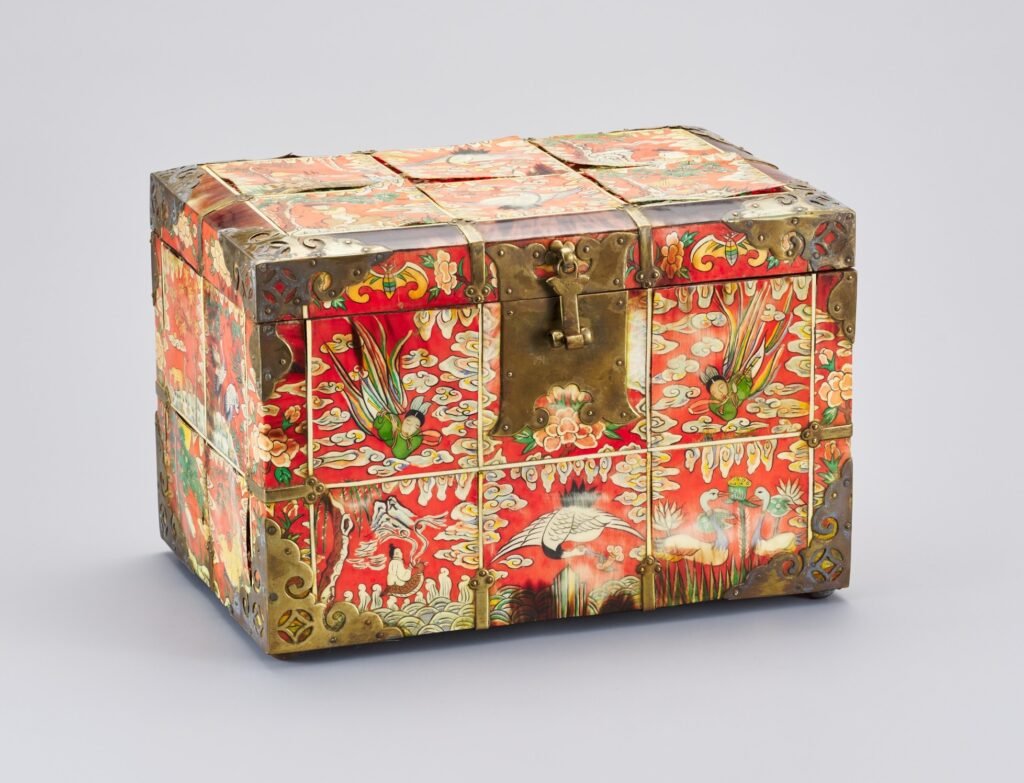
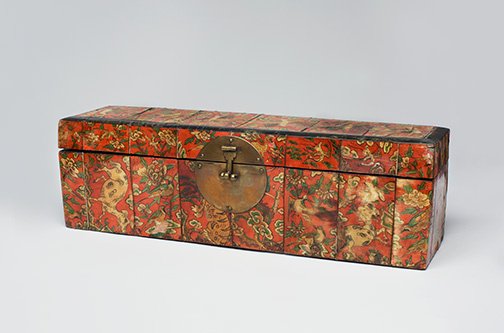
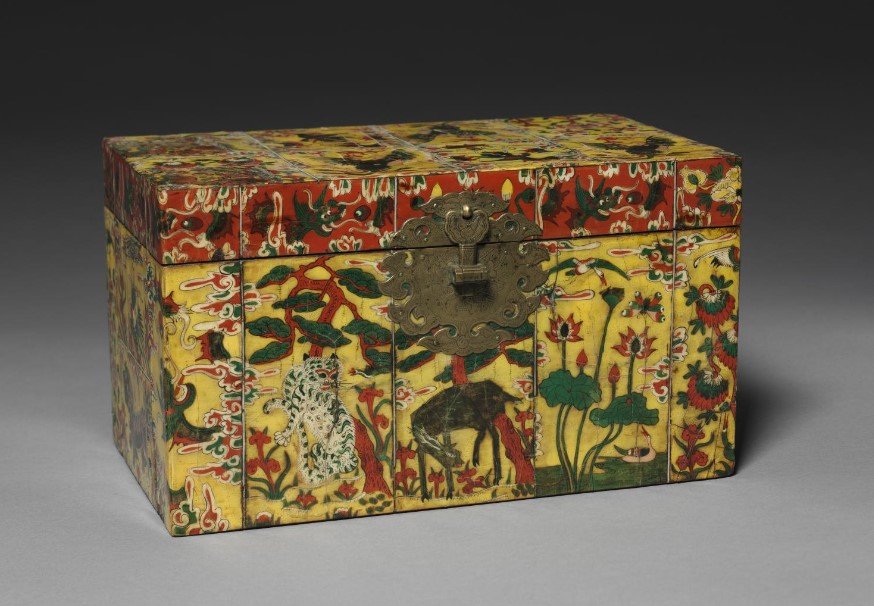
Cleveland Museum of art Korean collection
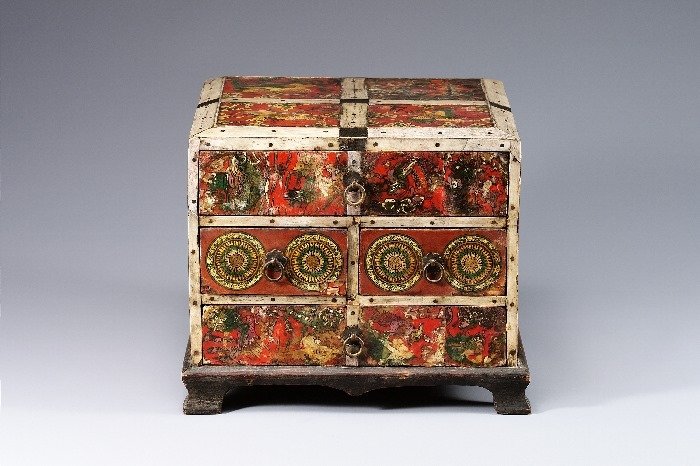
NATIONAL MUSEUM OF KOREA
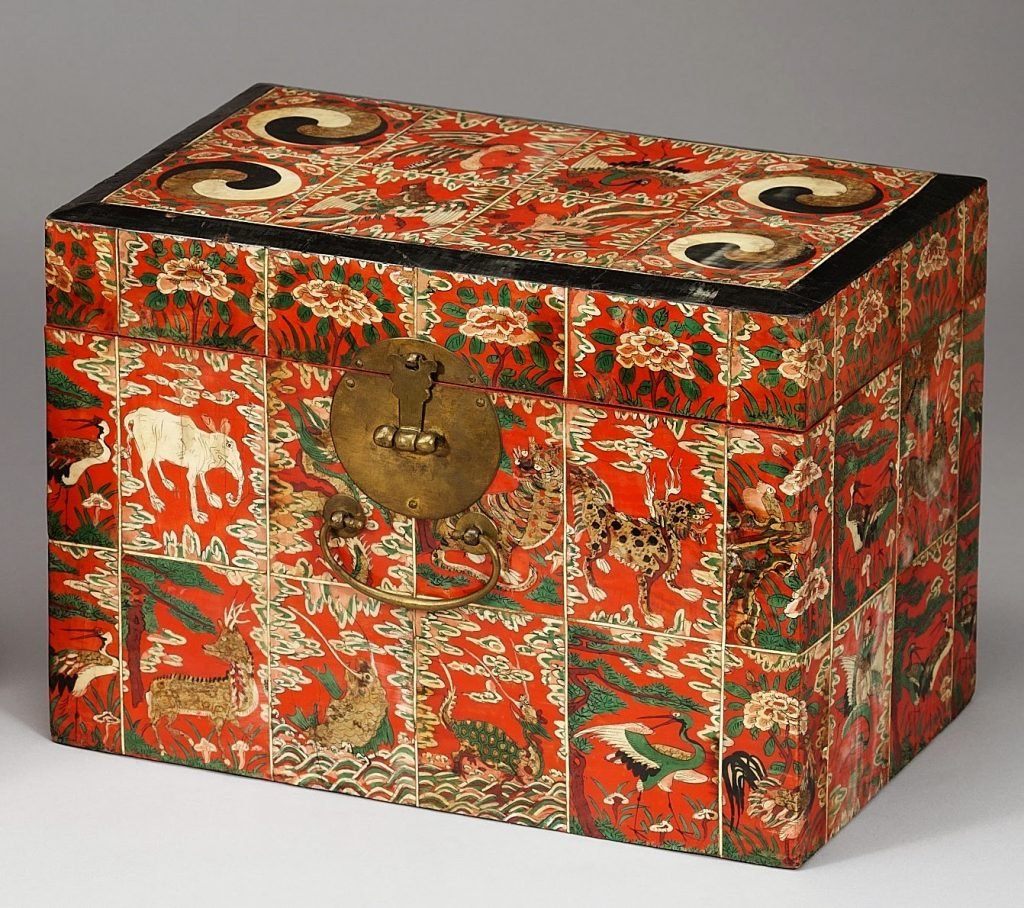
NATIONAL MUSEUM OF KOREA

with brass fittings. 18 x 30 x 20 cm. Joseon dynasty.
Late 18th-early 19th century
Collection St Louis Art Museum, Missouri, USA.
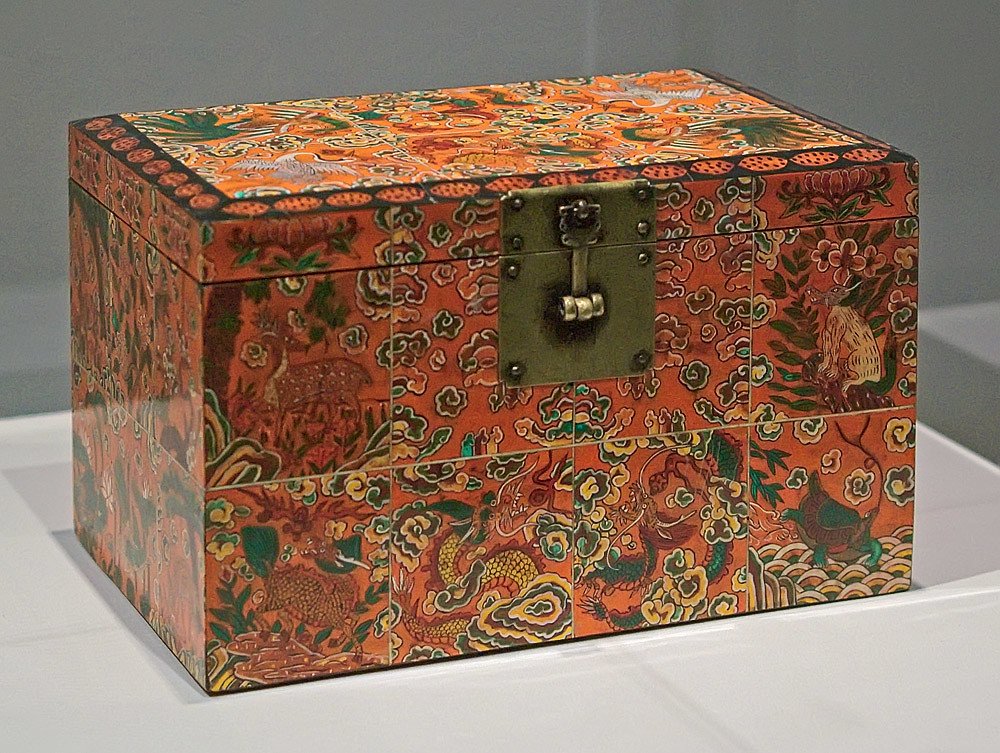
with brass fittings. 18 x 30 x 20 cm. Joseon dynasty.
Late 18th-early 19th century
Collection St Louis Art Museum, Missouri, USA.

Painted ox-horn and lacquer on wood.
H. 14cm, W. 22,2cm, D. 22,2cm.
Date: approx. 1800-1890.
Collection San Francisco Museum of Art.
The design motifs on this box have auspicious symbolism. The deer, turtle, and “yeongji” fungus, for instance, are longevity symbols, while the phoenix and peony represent peace, harmony, and prosperity.
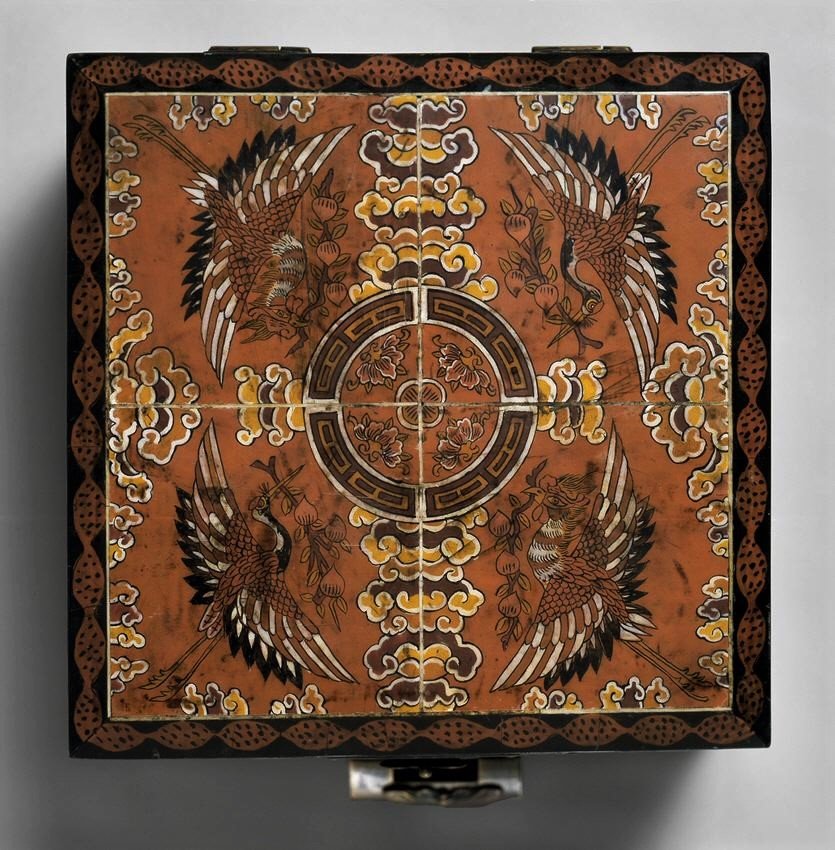
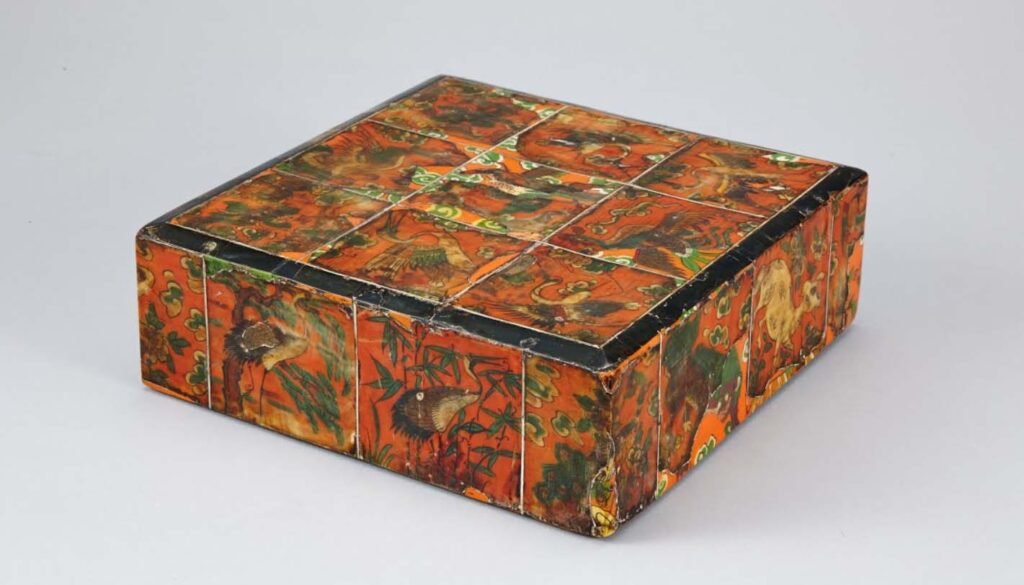
Joseon dynasty. 19th century.
Collection : Horim Museum, Seoul, Korea.
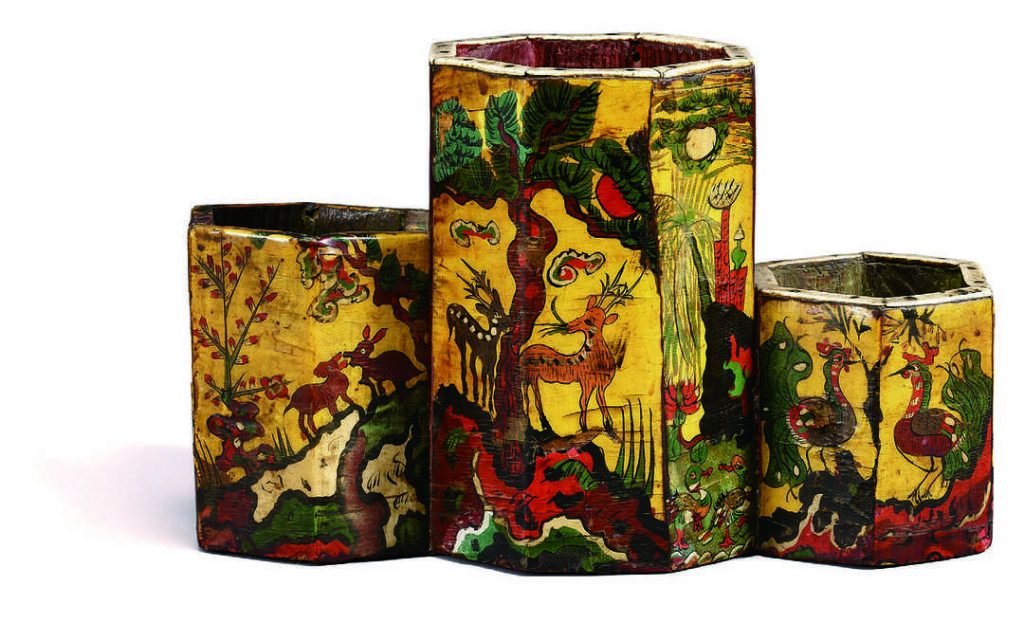
Joseon dynasty, 19th century.
H. 12,5cm. National Museum of Korea.
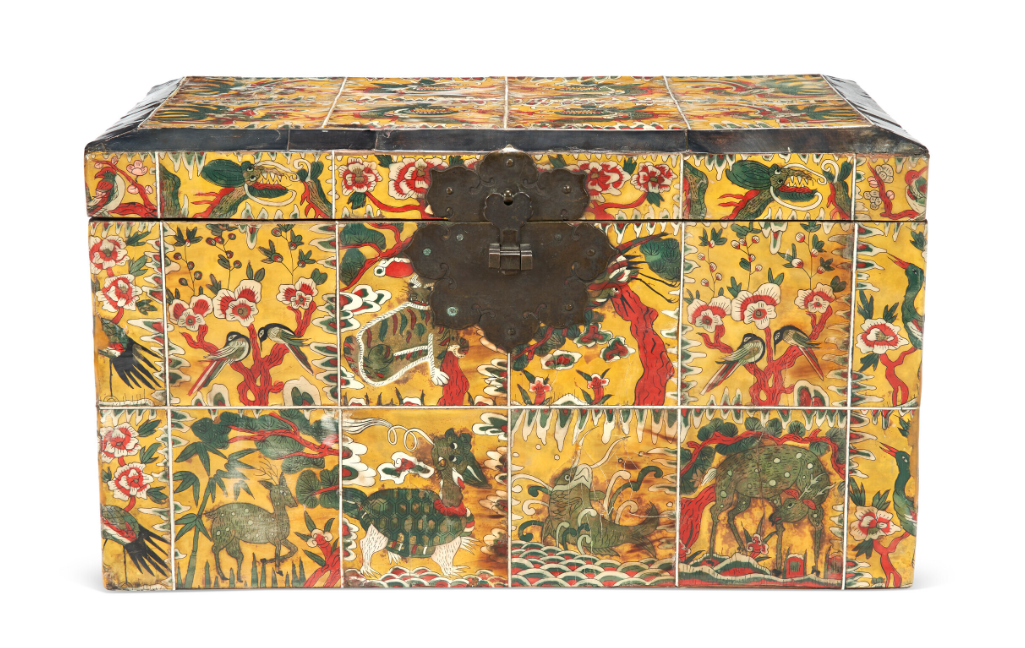
Estimate: $ 20,000 30,000.- SOLD for $ 63,000.-
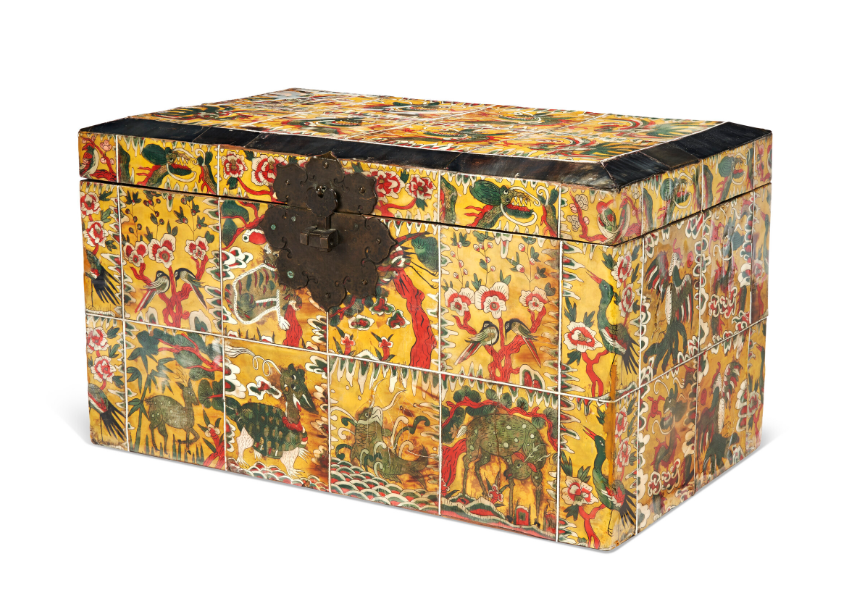
14 3/4 x 8 1/2 x 8 7/8 in. (37.5 x 21.6 x 22.5 cm.)
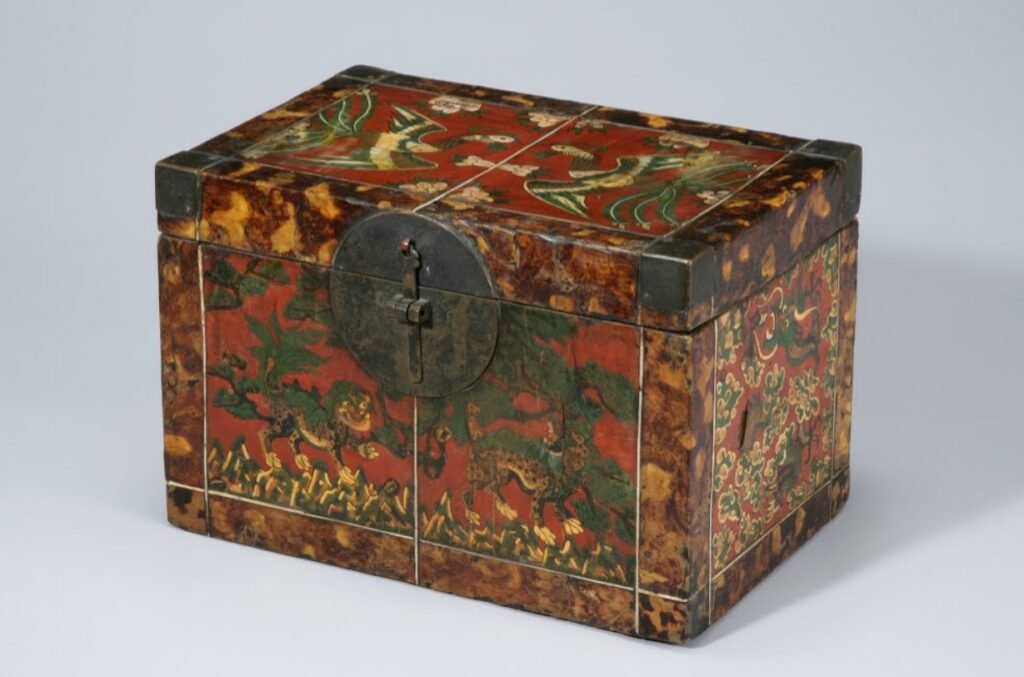
This is a square box made by drawing a picture on a thin plate made of ground ox horn and then attaching it to a pine board. The body is joined with a miter pattern. A round lock front base without any special decoration is attached to the front. The four corners of the lid are wrapped with simple square precious stones to firmly connect each board. Hinges are attached to two places on the back. Each side of the box depicts sacred animals. On the front, you can see two Haetae (legendary creature often depicted as a lion-like beast with a single horn, in different poses, on the side, a dragon wriggling in the clouds, on the back, a deer playing in the mountains, and on the lid, a phoenix facing each other. The division lines are made with thin ox bones, and each corner is finished with a tortoiseshell pattern. Collection: Horim Museum, Seoul. Korea.

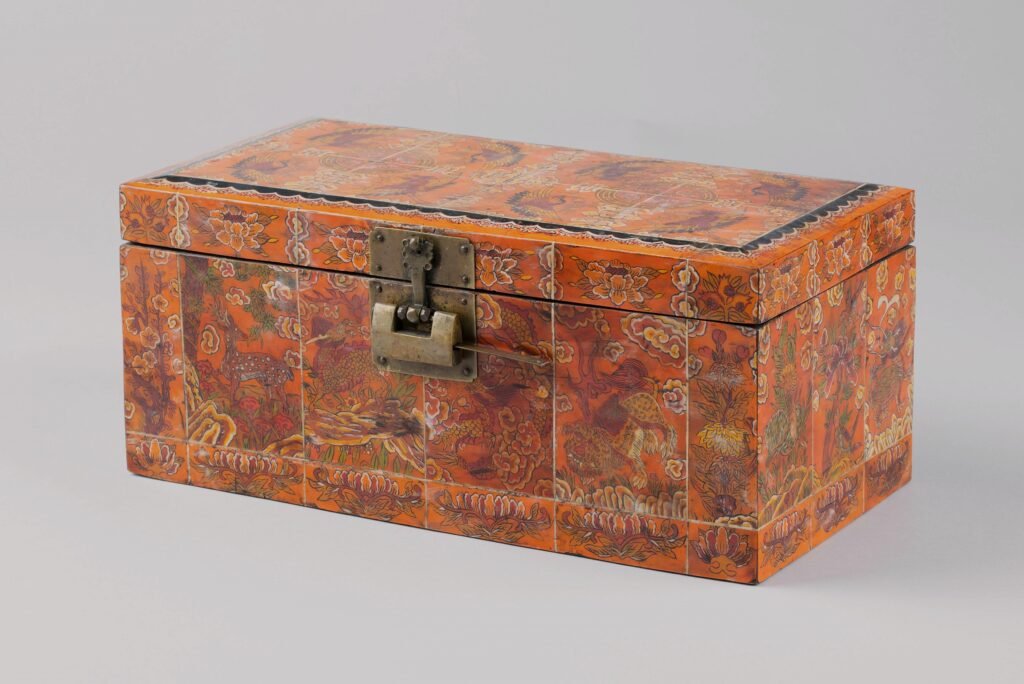
Collection: Korean National Folk Museum.

Vintage Korean Reverse Painted Ox Horn Brass Jewelry Cabinet, 1940s
The jewelry chest, or possibly collectors cabinet, is in the shape of a traditional Korean clothing cabinet, with a brass frame and brass fittings.
The doors inlaid with panels of reverse painted ox Horn. The inlaid panels delightfully reverse painted with Korean folk scenes against a vibrant red ground, in a technique called ‘hwagak’.The cabinet opens to reveal several storage areas, with another pair of doors above several drawers framed in bone with white brass fittings. The exterior of the cabinet with engraved brass panels of Confucian scholars under trees for the sides, and a water landscape with a duck in the foreground to the top. Inlaid reverse painting on ox horn, know as ‘hwagak’ in Korean, is a unique form of decoration originating during the Goryeo dynasty. The technique involves sections of horn flattened by water and heat, then sliced into thin, transparent sheets. The sheets are then reverse painted in bright colors before being inlaid on to various decorative items, usually boxes.
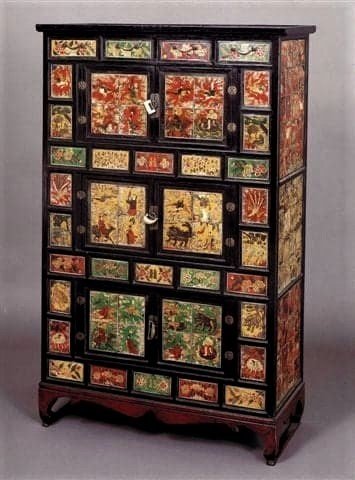
Three-Layered HWAGAK Chest, decorated with Ox-horn sheets
Joseon Dynasty, 19th century
H. 123cm, W. 77cm, D. 36cm.
Collection Korai Museum of Art, Kyoto, Japan.
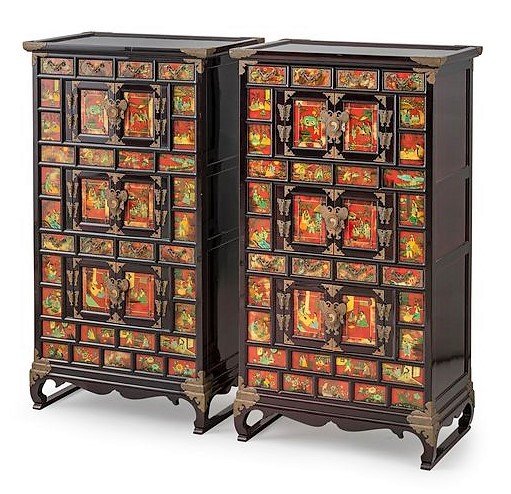
K Auction, Seoul, Korea.

Two level chest made of elm and paulownia woods with Inlaid reverse painting on ox horn, know as ‘hwagak‘. Furniture for storing clothing.
Deer motif in the upper part, duck and lotus in the lower part. The drawers have bamboo and sparrow decorations. The key is the character 雙”囍”.
H. 75,8cm, W. 50,7 D. 38,5cm.
Collection: National Folk Museum, Seoul, Korea.

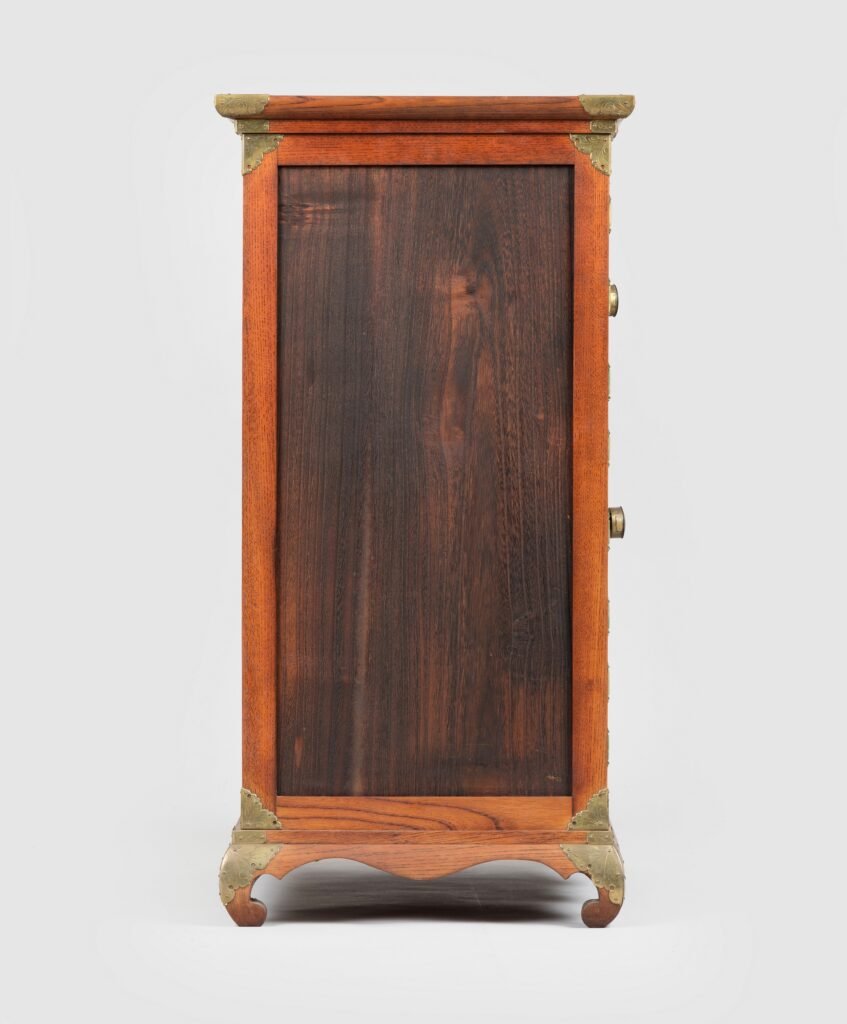

Culture: Korean
Date17th – 18th century
Medium: Wood with painted ox horn, brass fittings. Red and black lacquer, Tortoise shell, Polychrome, Metal
Dimensions: 44 x 28 x 15 1/2 inches (111.8 x 71.1 x 39.4 cm).
Collection: Dayton Art Institute. USA.

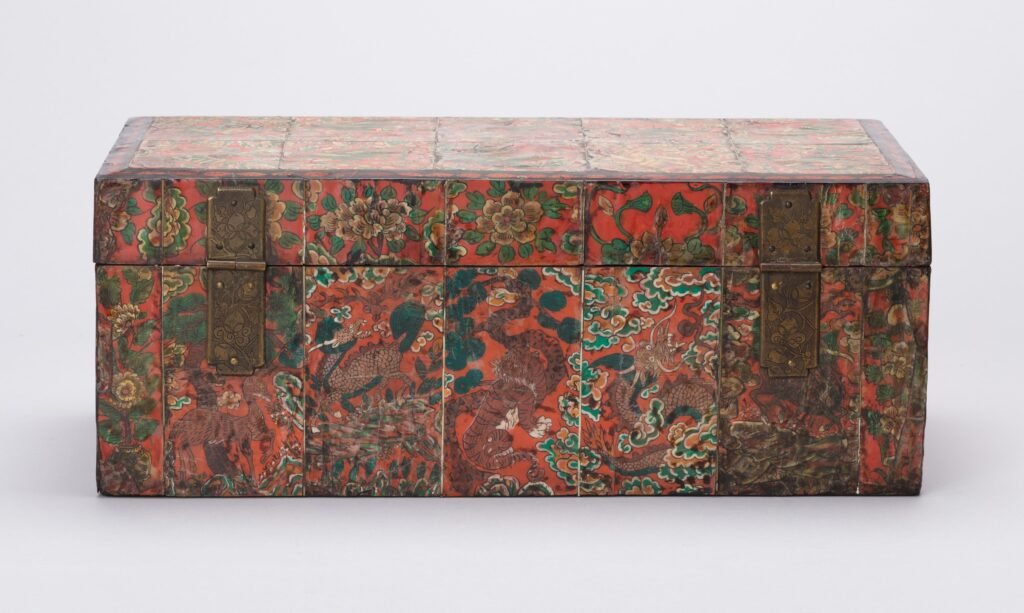
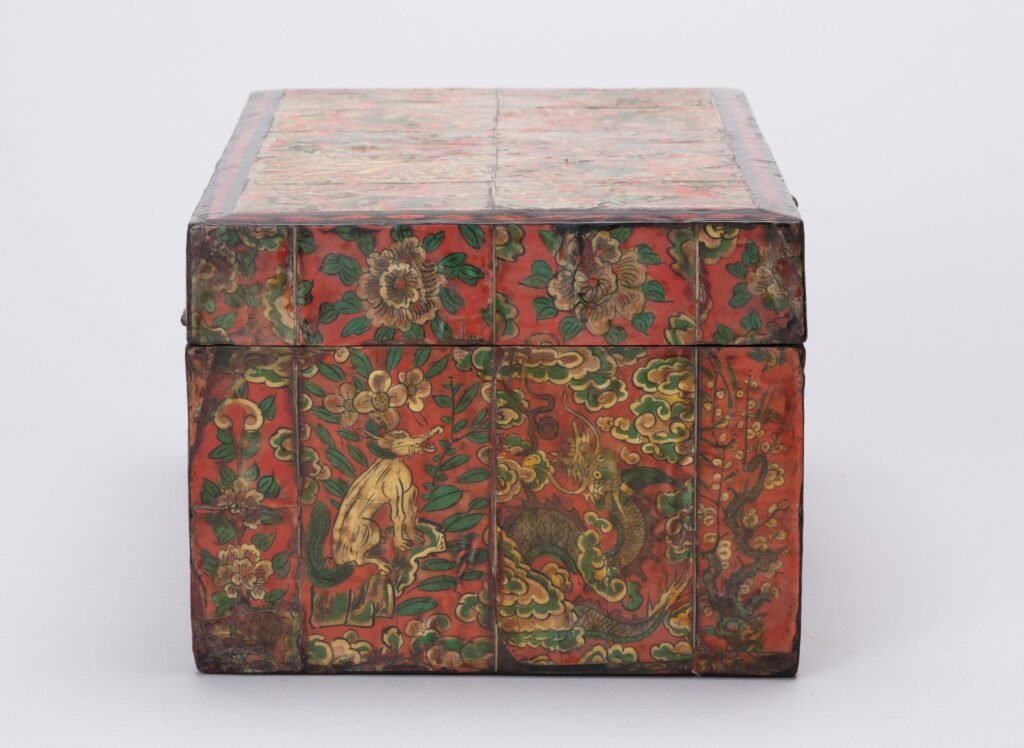
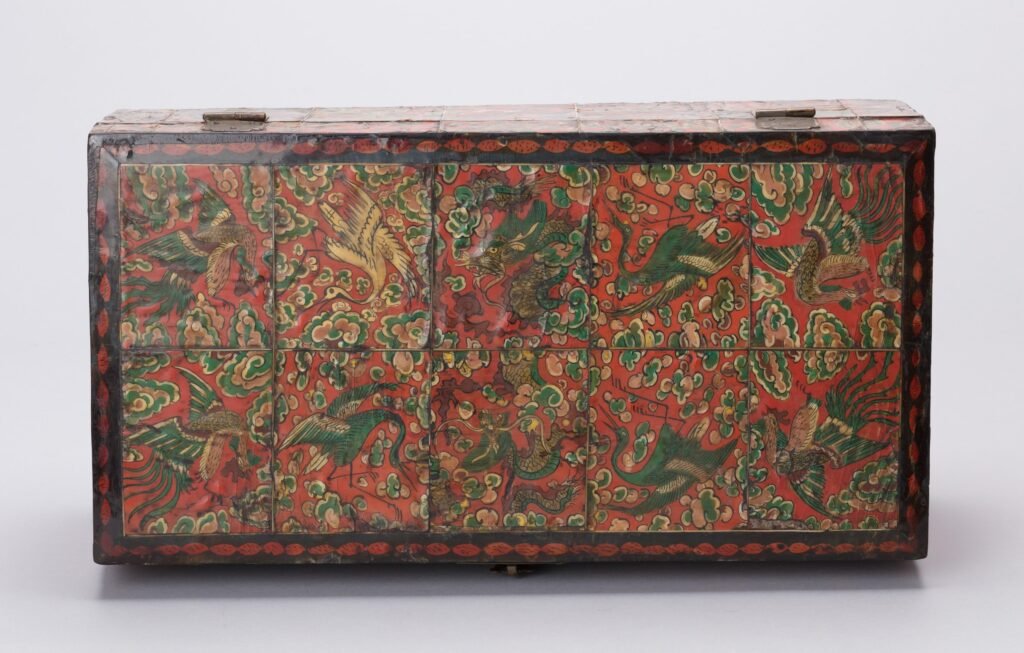
4 Photos above: Box with Design of Auspicious Symbols. Deer, monkey, dragon, tiger, crane, phoenix, peony, clouds, etc. are decorated with engravings on a red background. Korean paper is pasted inside the box. H. 21,5cm, W. 42,5cm, D. 17cm. Collection: National Folk Museum, Seoul.

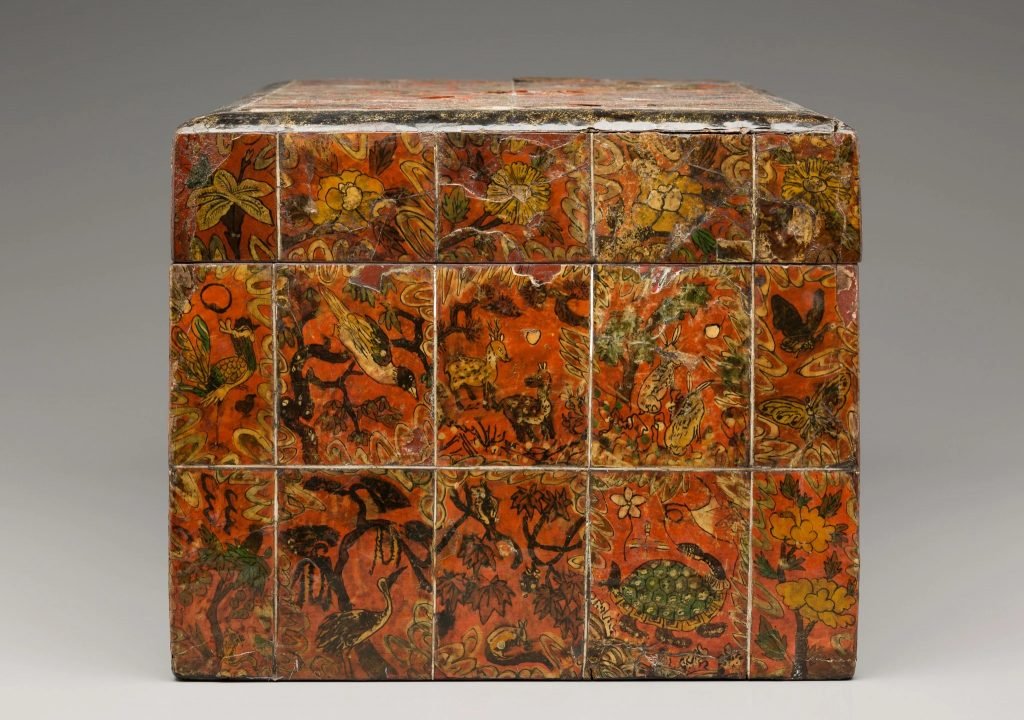
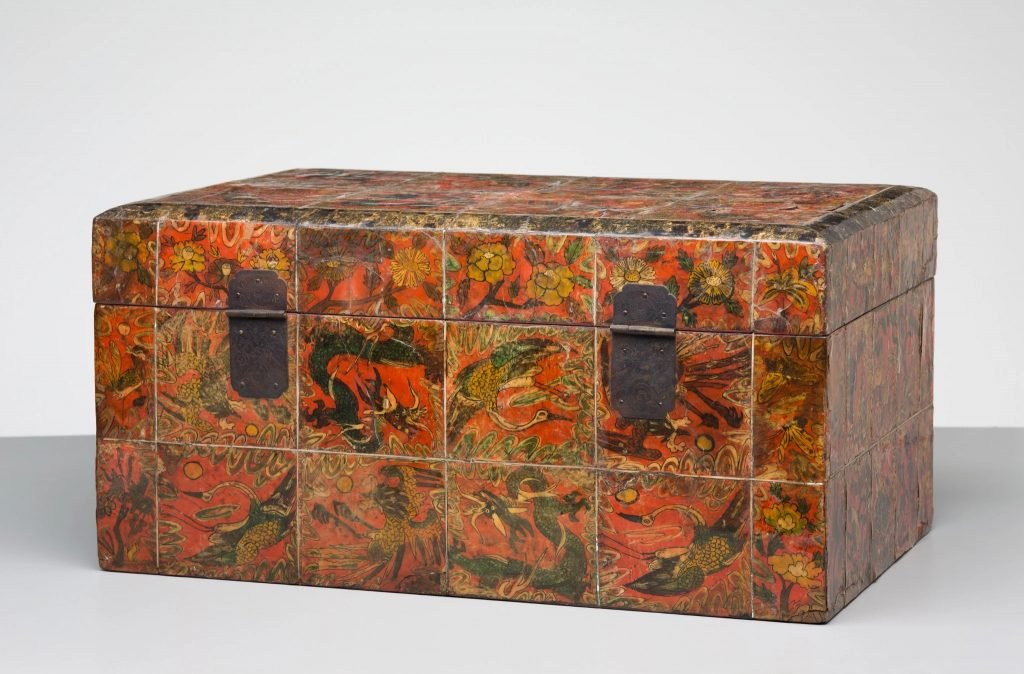

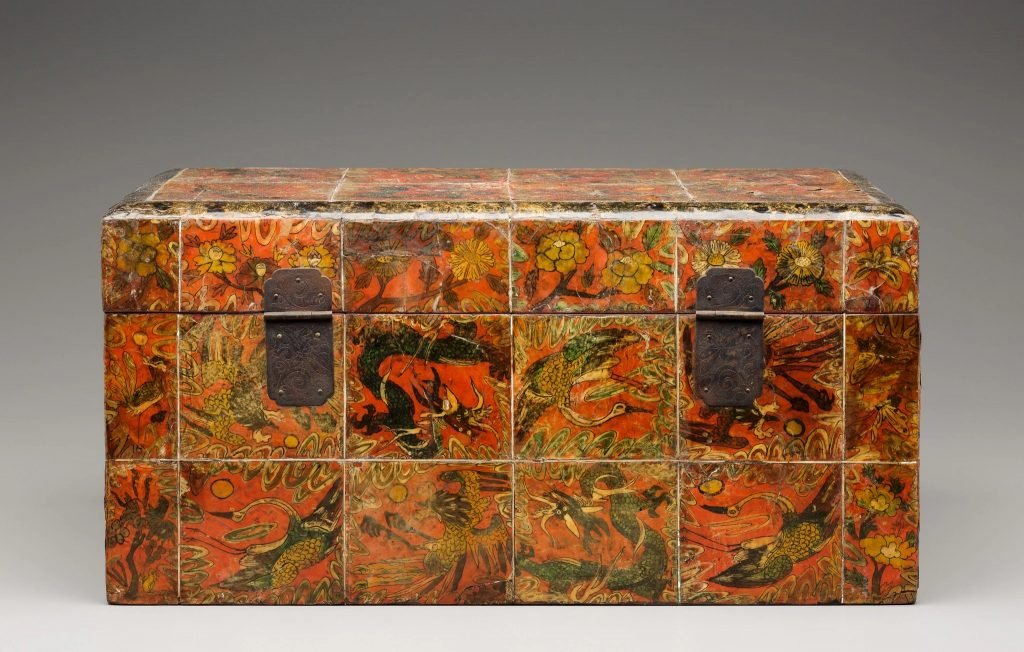
Box with Design of Auspicious Symbols, early 20th century.
Ink and paint on ox horn panels on wood, ray skin, and metal.
DETROIT INSTITUTE OF ART MUSEUM, USA

Joseon Dynasty. H. 24,3cm, 34,1cm x 21,8cm. Collection The National Museum of Korea.
Hwagak (華角) refers to a unique type of craftwork made with ox horns that have been cut and flattened into thin, translucent sheets. One side of these sheets would be painted with patterns or images, and then the painted side was attached to a wooden surface as decoration. Since ox horns are usually rather small, dozens of them were required to fully decorate even a small wooden object. Thus, hwagak crafts are known to be very complicated and difficult to produce. However, because of their vibrant, colorful decorative effect, hwagak products were quite popular, especially among women. This box is decorated with an array of plants and animals, including peonies, cranes, tigers, deer, turtles, and carp, as well as images of the Immortal Child (童子), who can be seen riding some of the animals against the bright red backdrop. The theme of the Immortal Child sitting astride an animal comes from Taoism, and was a common trope of hwagak. The top of the lid has a black border, and there is a taegeuk (yin-yang symbol) in each of the four corners. Arch-shaped iron handles are attached to the front and back of the box.
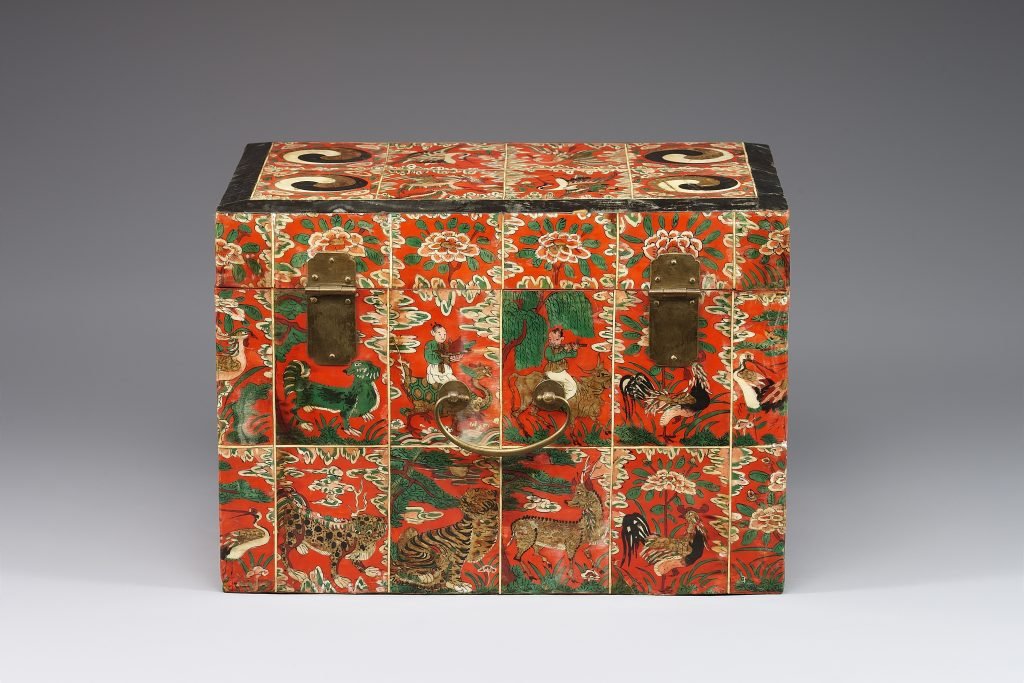

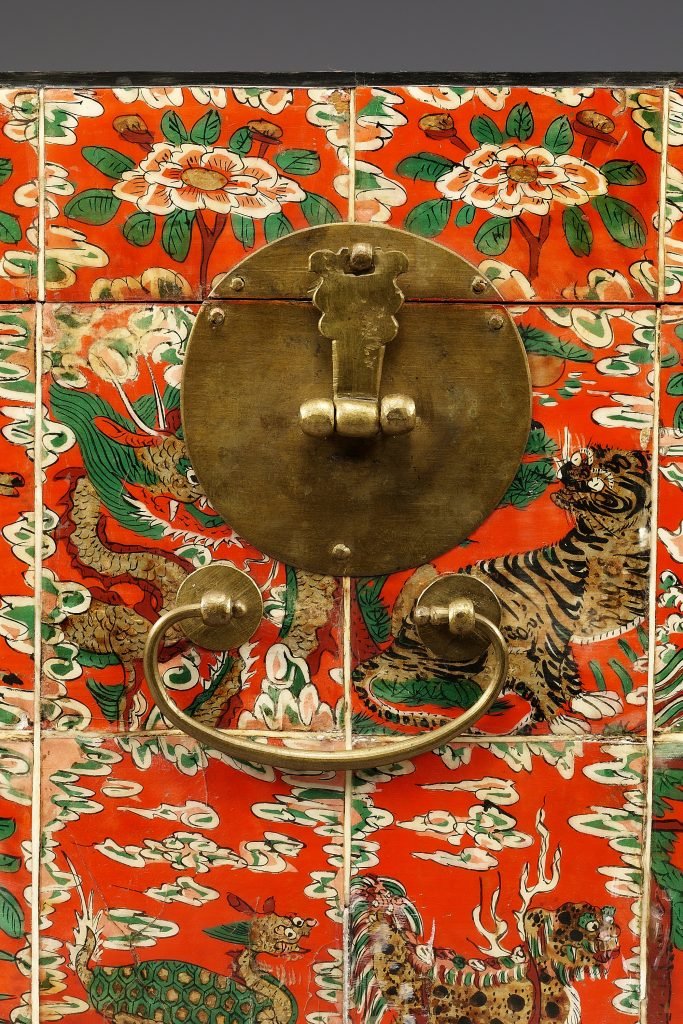
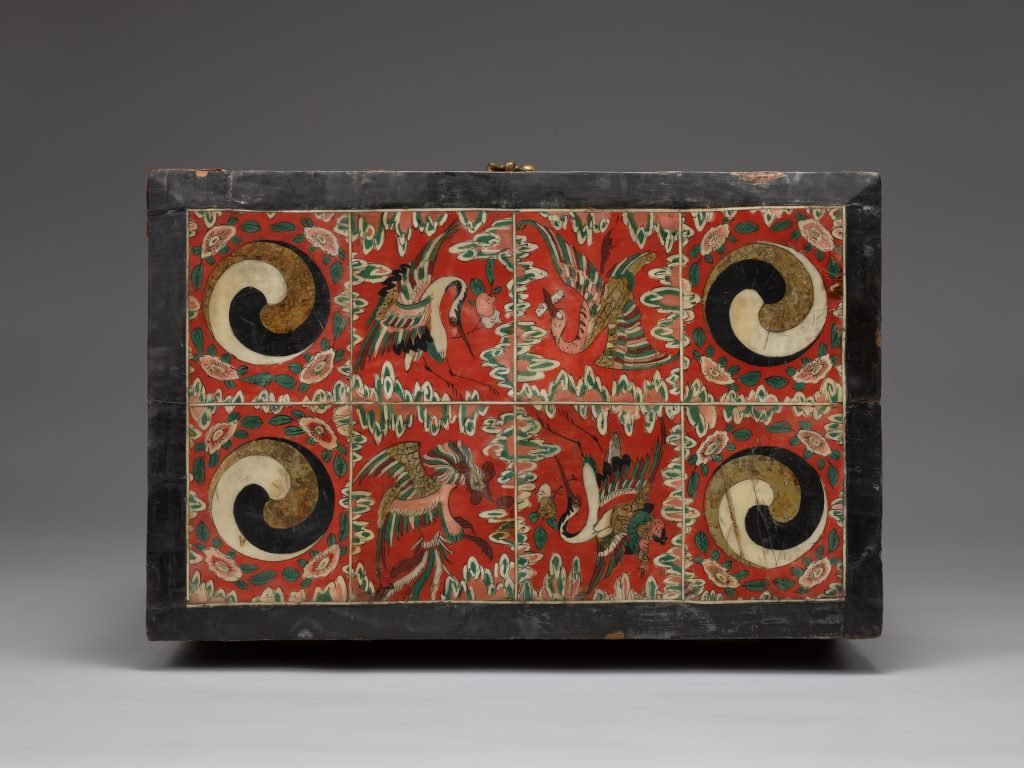
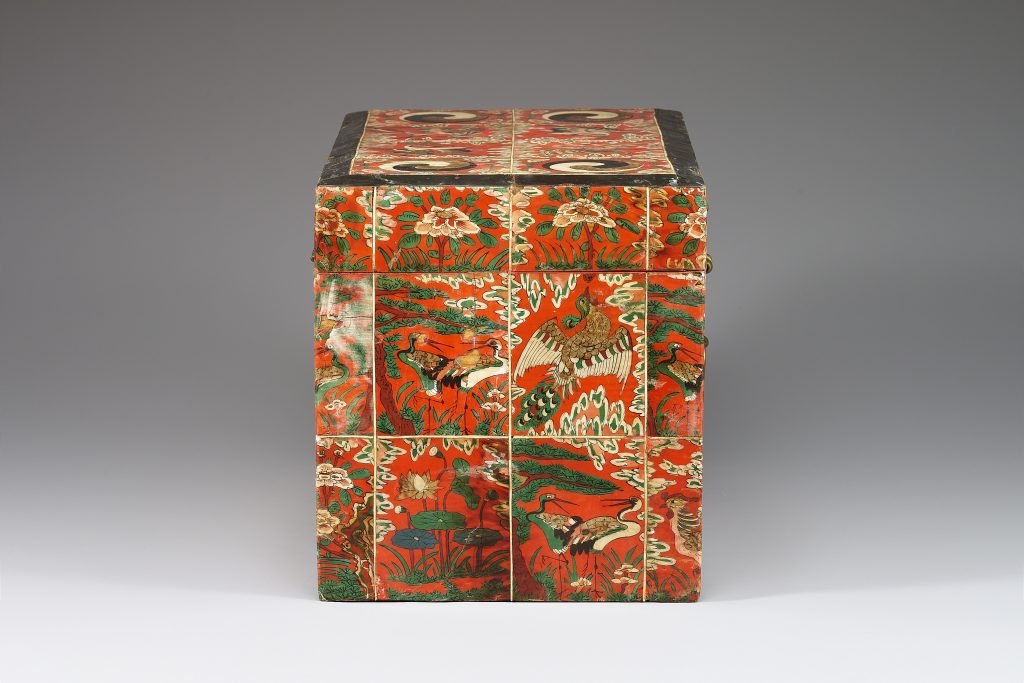

A Korean reverse painted oxhorn applied accessory box.
Joseon dynasty. Yellow brass fittings.
Height 21.2cm, W. 45,2cm, D, 24,4cm.
Presented at an auction in Seoul, Korea.
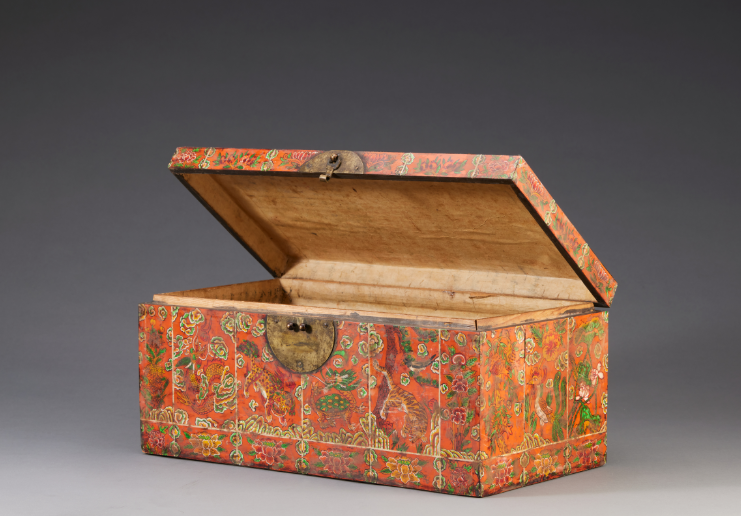
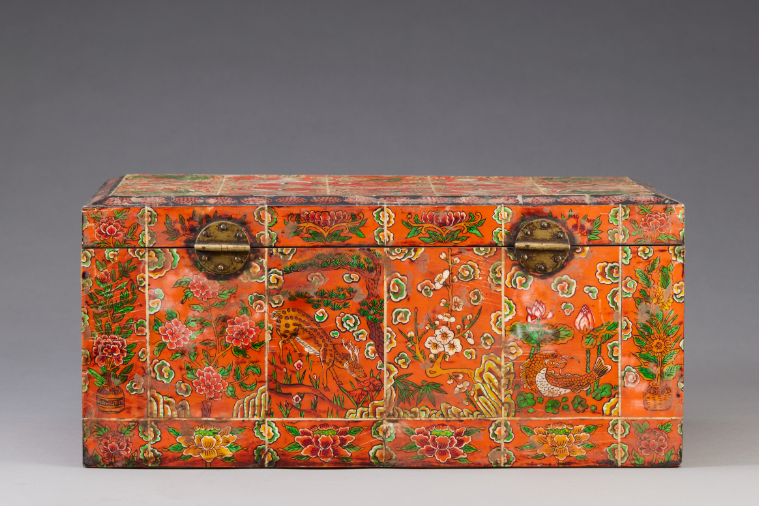
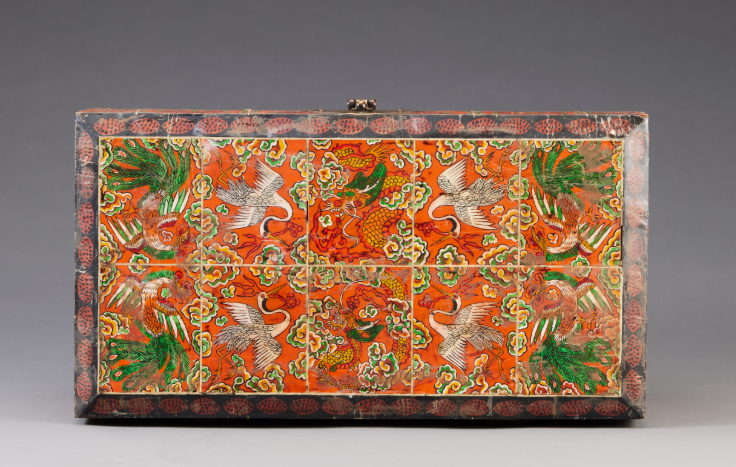
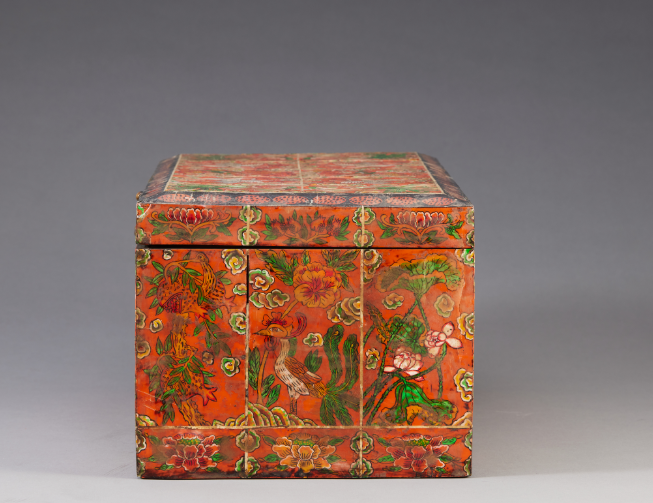
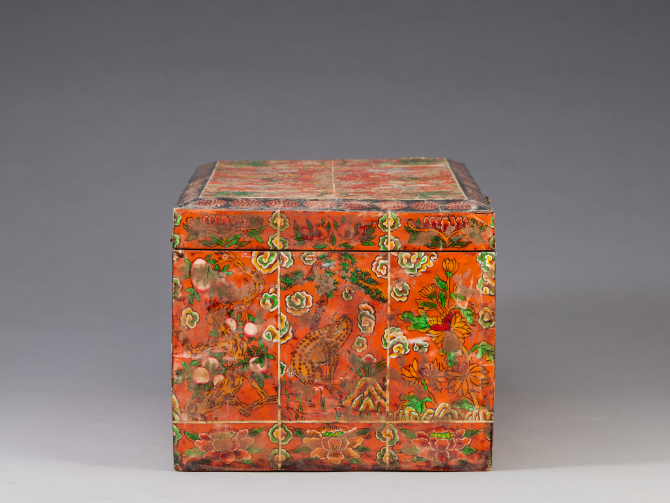
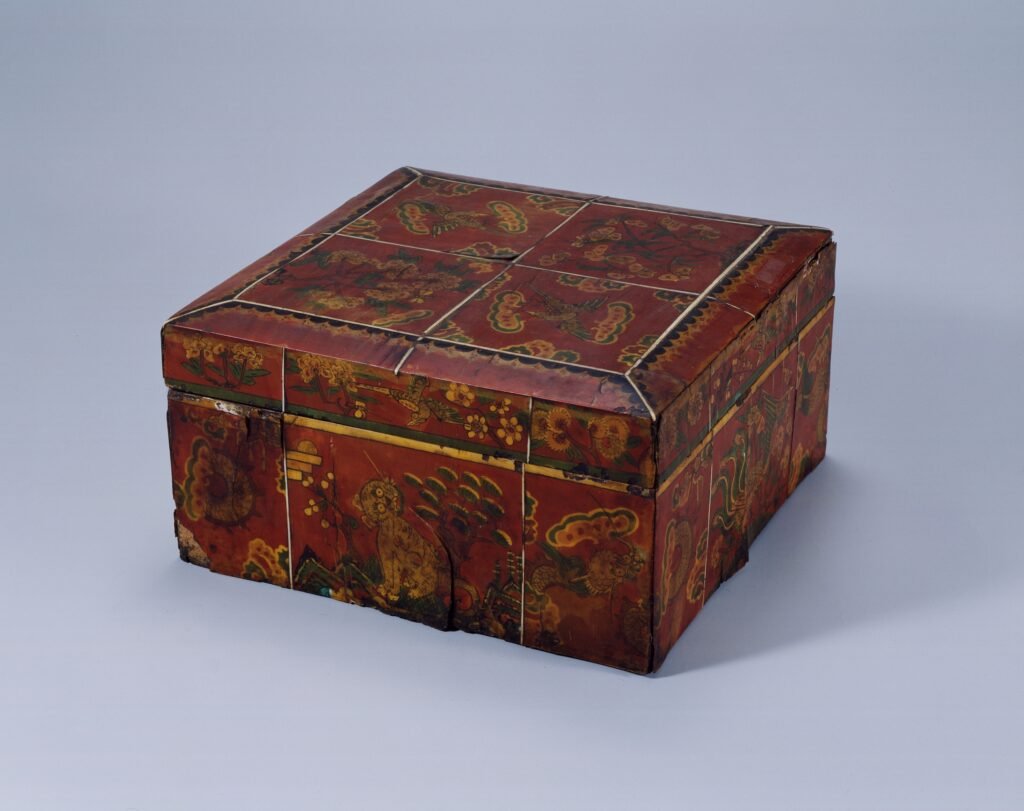
H. 13,2cm, W. 24,3cm, D. 24,3cm.
Collection National Museum of Korea.

H. 22,2cm, Diameter: 31,4cm.
Collection National Museum of Korea.
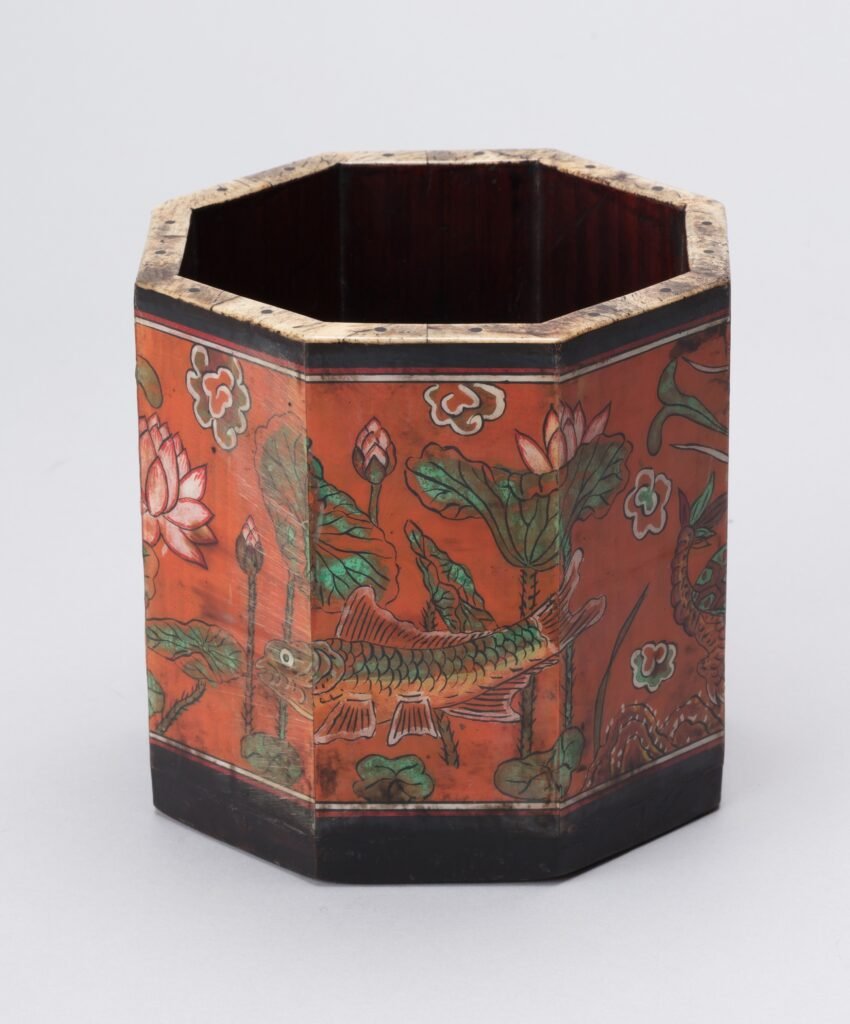
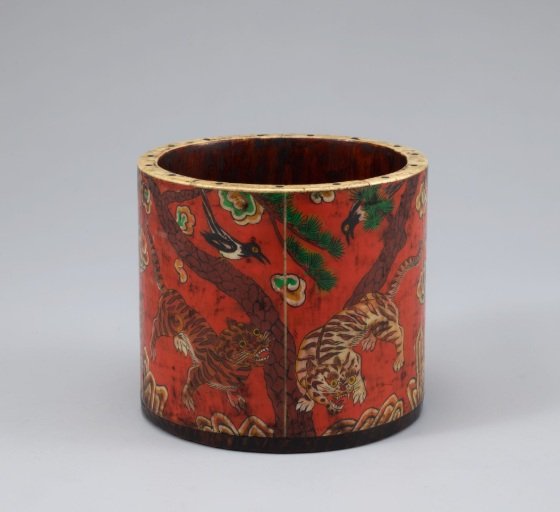
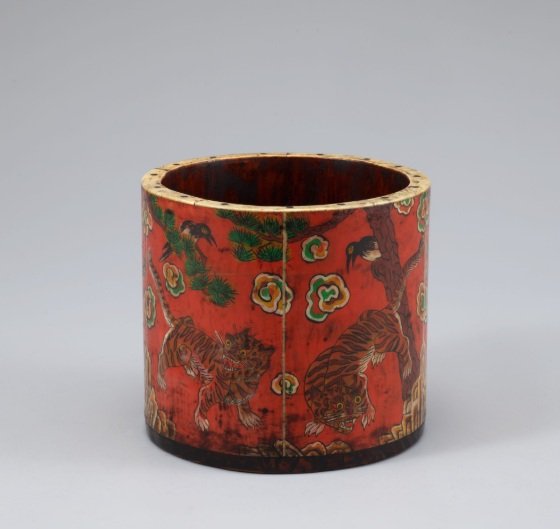

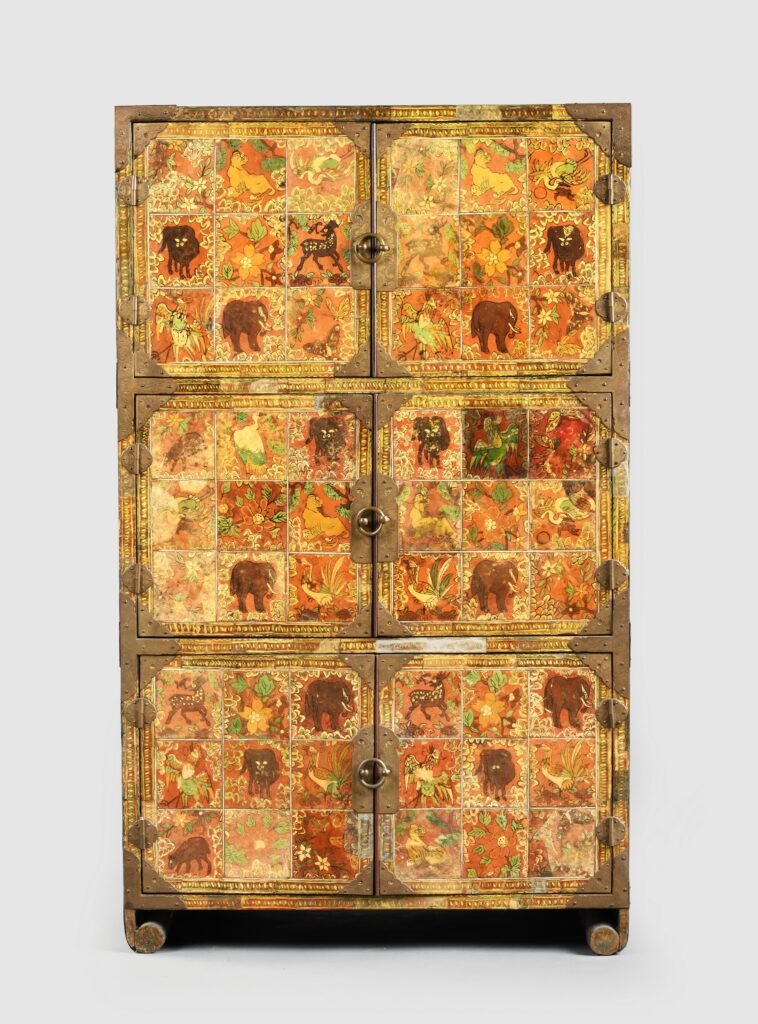
Collection: National Folk Museum of Korea.
